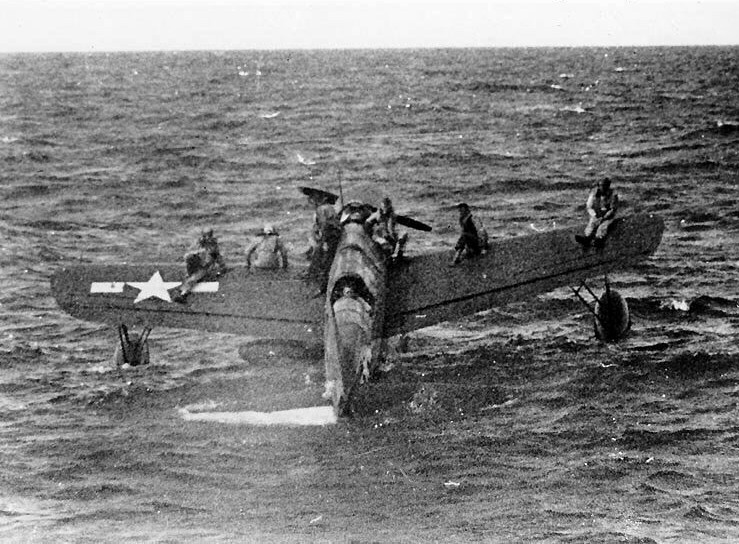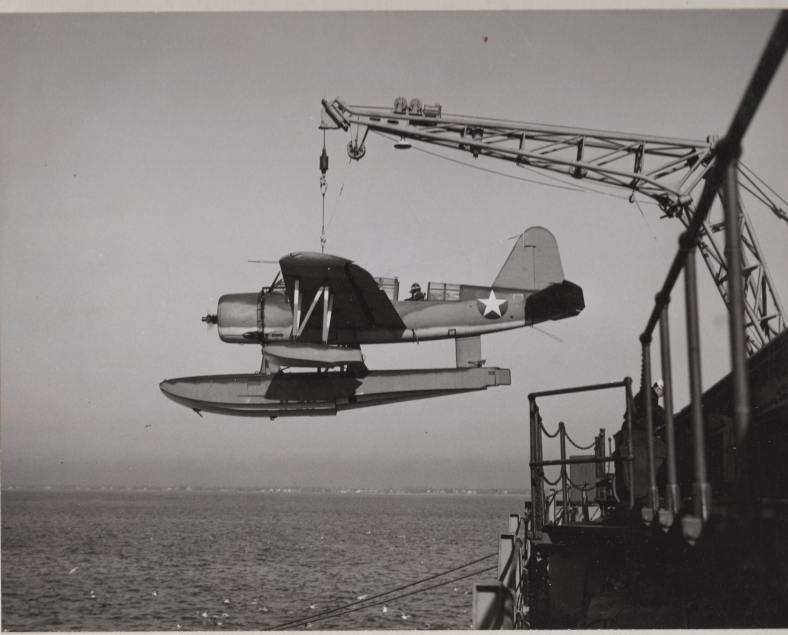 (At the upper right of this photo of bluejackets performing exercises on the aft deck of Iowa in July 1944, you can just see two OS2U floatplanes mounted on catapults the fantail. The crane used to retrieve the planes is folded between the catapults.)
(At the upper right of this photo of bluejackets performing exercises on the aft deck of Iowa in July 1944, you can just see two OS2U floatplanes mounted on catapults the fantail. The crane used to retrieve the planes is folded between the catapults.)
…but not in the way you think.
Among the least-known and most surprising tools in Iowa’s World War II arsenal were OS2U Kingfisher floatplanes, small single-wing seaplanes with floatation devices under the fuselage and wings. These planes were not designed to taxi and takeoff from the ship or from the ocean. Instead they were mounted on catapults on the fantail, at the ship’s stern, and on takeoff they were literally hurled into the air. What an experience that must have been!

(Here Iowa’s starboard catapult launches an OS2U, while the port catapult is preparing to launch another in the same direction. A third plane rests on a dolly in the center of the deck.)
OS2Us were observation planes. They carried a crew of two, a pilot and an observer, seated in separate compartments, one behind the other. Their range was about 805 miles and their maximum speed, 164 mph. On battleships they were used as spotters to increase the effectiveness of bombardment operations. The observer would note the strike point of shells fired by the ship’s guns and send back aim adjustment information to make those strikes more effective. Floatplanes were also sent on scouting missions to locate nearby craft, survivors of damaged or sunken ships, and downed airmen. Some played a significant role in the rescue of men at sea and the transport of the injured. Unfortunately, I have no information about specific operations of Iowa’s floatplanes.

(This is an OS2U off Truk in 1944 participating in the rescue of downed airmen by supporting them on its wings until the arrival of other transportation.)
OS2Us had minimal armament. The pilot and observer each had a machine gun, and at least one OS2U (not from Iowa) was credited with bringing down an enemy plane. Floatplanes also had the capacity to carry up to 650 pounds of bombs, smoke pots and/or depth charges. A few managed to sink submarines. Given opportunity and an imaginative and daring crew, a floatplane could be a surprisingly effective instrument of war.
The OS2U’s return to its mother ship was as spectacular as its takeoff, but considerably slower. Upon completion of its mission, the plane landed in the ocean near its ship. A large crane in the center of the fantail between the catapults hoisted the plane from the water, lifted it high, and returned it to its catapult with the assistance of seamen on the ship.

(Here Iowa‘s crane reaches over the side and lifts an OS2U onto the ship.)

(Here a crane on Iowa‘s sister ship, USS Missouri, lowers an OS2U onto its catapult.)
Technological advances after the war made the OS2U obsolete, but in its day the floatplane was a nifty and useful resource on a battleship.
assume helicopters did not yet exist? interesting about these little seaplanes…
LikeLike
Sikorski developed a primitive helicopter in 1939, but helicopters weren’t used militarily until the Korean War.
LikeLike
My Dad flew this aircraft off the USS IOWA in 1948.
LikeLike